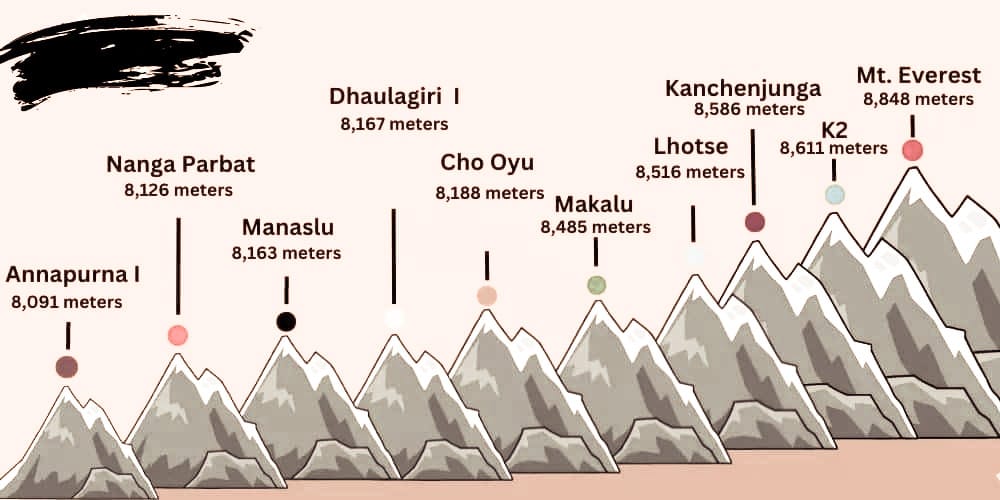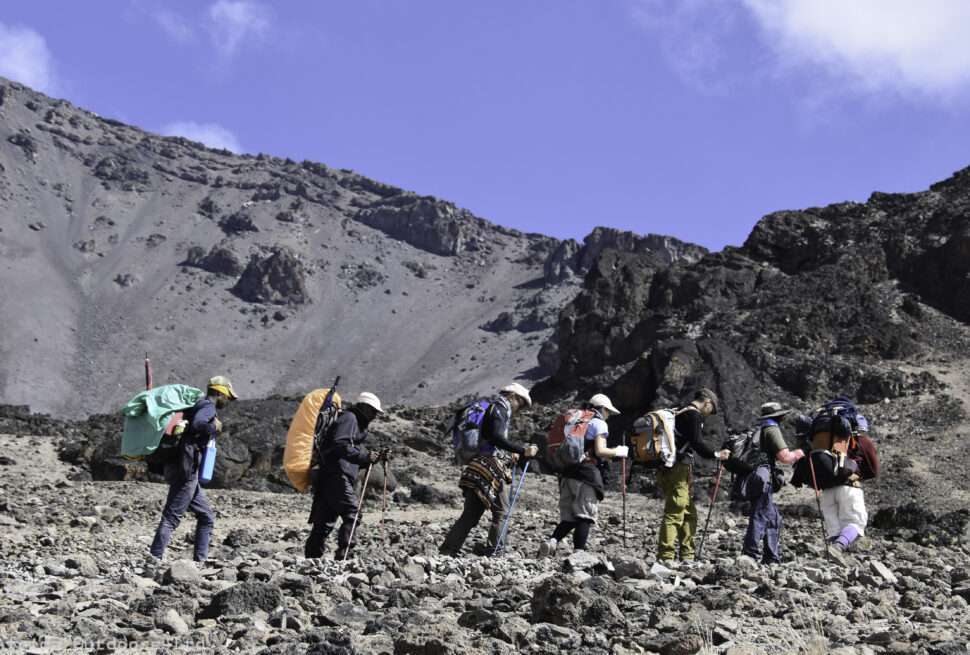Discover the world’s highest mountains in our exploration of awe-inspiring peaks that punctuate the Earth’s surface. From the iconic summit of Mount Everest to the formidable heights of K2, our guide takes you on a virtual ascent through the Top 10 Highest Mountains in the World.
As we delve into the elevations and geographical significance of each peak, we aim to provide a comprehensive resource for mountain enthusiasts and adventurers alike. From the Himalayas to the Karakoram Range, join us on this expedition as we unravel the stories and statistics behind these monumental natural wonders.
Whether you’re a seasoned mountaineer or an armchair explorer, our curated insights into these towering giants promise to elevate your understanding of Earth’s grandest landscapes. Read on as we navigate the heights, revealing the Top 10 Highest Mountains and their captivating narratives.
Table of Contents
- 1. Mount Everest
- 2. K2
- 3. Kangchenjunga
- 4. Lhotse
- 5. Makalu
- 6. Cho Oyu
- 7. Dhaulagiri I
- 8. Manaslu
- 9. Nanga Parbat
- 10. Annapurna I
10 Highest Mountains in the World

| Name of Mountains | Elevation | Country/Location |
| Mount Everest | 8,848 meters (29,029 feet) | Nepal/China (border) |
| K2 | 8,611 meters (28,251 feet) | Pakistan/China (border) |
| Kanchenjunga | 8,586 meters (28,169 feet) | Nepal/India (border) |
| Lhotse | 8,516 meters (27,940 feet) | Nepal/China (border) |
| Makalu | 8,485 meters (27,838 feet) | Nepal/China (border) |
| Cho Oyu | 8,188 meters (26,864 feet) | Nepal/China (border) |
| Dhaulagiri I | 8,167 meters (26,795 feet) | Nepal |
| Manaslu | 8,163 meters (26,781 feet) | Nepal |
| Nanga Parbat | 8,126 meters (26,660 feet) | Pakistan |
| Annapurna I | 8,091 meters (26,545 feet) | Nepal |
Please note that these elevations are approximate and can vary due to factors such as glacial melting and shifting tectonic plates.
1. Mount Everest
Elevation: 8,848 meters (29,029 feet)
Location: Nepal/China (border)
Embracing the Summit: Unveiling the Tallest Peak on Earth
Nestled in the heart of the Himalayas, Mount Everest reigns supreme as the world’s highest mountain. Towering at an awe-inspiring 8,848 meters, the summit has been a beacon for intrepid climbers and adventurers for decades.
Key Highlights:
- Explore the history of Everest expeditions, from the first successful ascent by Sir Edmund Hillary and Tenzing Norgay in 1953 to modern-day triumphs.
- Dive into the challenges posed by the treacherous Khumbu Icefall, the notorious Hillary Step, and the unpredictable weather that defines Everest’s mystique.
- Discover the cultural significance of Everest to the local Sherpa communities and the impact of mountaineering tourism on the region.
Fun Fact:
Did you know that the height of Mount Everest is not static? Due to tectonic activity, the mountain’s elevation is subject to change over time.
2. K2
Elevation: 8,611 meters (28,251 feet)
Location: Pakistan/China (border)
Conquering the Savage Mountain: K2’s Unforgiving Majesty
Known as the “Savage Mountain,” K2 is the second-highest peak globally, notorious for its challenging ascent and perilous conditions. Standing proudly at 8,611 meters, this colossal peak in the Karakoram Range demands respect from even the most seasoned mountaineers.
Key Highlights:
- Explore the history of K2 expeditions, from early attempts to the first successful summit in 1954 by an Italian team led by Ardito Desio.
- Uncover the technical difficulties posed by K2’s steep slopes, unpredictable weather, and the notorious “Bottleneck” and “Abruzzi Spur” sections.
- Delve into the cultural significance of K2 to the indigenous people of the Karakoram and the impact of climbing on the local communities.
Fun Fact:
Unlike Everest, K2 has never been climbed in winter until now. At 5 P.M. local time on Saturday, January 16, 2021Nepalese team makes the first successful winter ascent of K2.
3. Kangchenjunga
Elevation: 8,586 meters (28,169 feet)
Location: Nepal/India (border)
Into the Realm of Five Treasures: Kangchenjunga’s Majestic Heights
Venture into the eastern Himalayas to discover Kangchenjunga, the third-highest mountain standing proudly at 8,586 meters. Revered by locals as the “Five Treasures of Snow,” this peak unfolds a tale of spiritual significance and natural splendor.
Key Highlights:
- Learn about the folklore surrounding Kangchenjunga and its cultural importance to the indigenous communities, particularly in Sikkim and Nepal.
- Explore the challenges faced by climbers on Kangchenjunga’s demanding routes, such as the North Ridge and the awe-inspiring Yalung Glacier.
- Unearth the unique biodiversity of the Kangchenjunga Conservation Area, home to rare flora and fauna thriving in the shadow of this colossal peak.
Fun Fact:
Kangchenjunga is the only 8,000-meter peak that has never been climbed from its northeastern side in India, as the region is strictly protected.
4. Lhotse
Elevation: 8,516 meters (27,940 feet)
Location: Nepal/China (border)
The Neighbor of Everest: Lhotse’s Silent Grandeur
Standing shoulder to shoulder with Everest, Lhotse offers a formidable challenge to mountaineers with its soaring heights of 8,516 meters. Explore the symbiotic relationship between Everest and Lhotse and the distinct allure that sets Lhotse apart.
Key Highlights:
- Uncover the shared history of Everest and Lhotse expeditions, as climbers often attempt both summits in a single journey.
- Delve into the technical difficulties posed by Lhotse’s infamous couloirs and the demanding climb along the South Face.
- Gain insight into the geological forces that shaped the Everest-Lhotse massif and the interconnected ecosystems of the Khumbu region.
Fun Fact:
Lhotse Middle (East) and Lhotse Shar (South) are considered separate peaks, each exceeding 8,400 meters in height.
5. Makalu
Elevation: 8,485 meters (27,838 feet)
Location: Nepal/China (border)
Rising from the Shadows: Makalu’s Enigmatic Presence
Journey into the heart of the Himalayas to discover Makalu, the fifth-highest mountain soaring to 8,485 meters. With its distinct pyramid shape, Makalu beckons adventurers to explore its lesser-known, yet equally challenging, routes.
Key Highlights:
- Explore the geological history that shaped the Makalu-Barun Valley and the unique features of Makalu’s four challenging ridges.
- Uncover the allure of the Makalu Base Camp trek, offering stunning views of the peak and a rich tapestry of biodiversity.
- Gain insights into the cultural significance of Makalu to the local Sherpa communities and the balance between conservation and mountaineering.
Fun Fact:
Makalu is renowned for its challenging climb, attracting experienced mountaineers seeking a less crowded alternative to Everest.
6. Cho Oyu
Elevation: 8,188 meters (26,864 feet)
Location: Nepal/China (border)
The Turquoise Goddess: Cho Oyu’s Tranquil Majesty
As we ascend further into the realms of the Himalayas, Cho Oyu emerges as the sixth-highest mountain, reaching an elevation of 8,188 meters. Known as the “Turquoise Goddess,” Cho Oyu stands as a testament to both beauty and challenge.
Key Highlights:
- Explore the history of Cho Oyu expeditions and its significance as a training ground for Everest climbers.
- Delve into the allure of the Northwest Face and the fascinating ice formations that characterize Cho Oyu’s slopes.
- Understand the unique weather patterns around Cho Oyu and the strategic acclimatization required for a successful ascent.
Fun Fact:
Cho Oyu is considered one of the more “achievable” 8,000-meter peaks, attracting climbers aiming to summit an 8,000-meter peak without the extreme technical difficulties of other giants.
7. Dhaulagiri I
Elevation: 8,167 meters (26,795 feet)
Location: Nepal
Guardian of the Gorges: Dhaulagiri’s Remote Majesty
In the heart of the Annapurna region stands Dhaulagiri I, the seventh-highest mountain reaching a commanding height of 8,167 meters. Known for its towering peaks and challenging terrain, Dhaulagiri presents a formidable ascent for the adventurous.
Key Highlights:
- Uncover the geological forces that shaped the Dhaulagiri Massif and the unique features of its seven main summits.
- Explore the challenges posed by the Northeast Ridge and the towering icefall, known as the “Colossal Ice Pyramid.”
- Discover the cultural significance of Dhaulagiri to the Gurung people and the impact of climbing on the remote villages in its shadow.
Fun Fact:
Dhaulagiri was the first 8,000-meter peak to be climbed, with a successful ascent in 1960 by an international team.
8. Manaslu
Elevation: 8,163 meters (26,781 feet)
Location: Nepal
Rising Above the Annapurna: Manaslu’s Tranquil Dominance
Manaslu, the eighth-highest mountain on our list, commands attention with its majestic heights reaching 8,163 meters. Nestled in the Nepalese Himalayas, Manaslu offers climbers a serene yet challenging alternative to its neighboring giants.
Key Highlights:
- Explore the history of Manaslu expeditions and the allure of its less-crowded trails compared to other popular peaks.
- Delve into the challenges posed by the Northeast Face and the intricate ice features along the standard route.
- Understand the cultural significance of Manaslu to the local communities and the delicate balance between conservation and climbing.
Fun Fact:
Manaslu was opened to climbers in 1991, later than some of its neighboring peaks, contributing to its reputation as a pristine and less-traveled destination.
9. Nanga Parbat
Elevation: 8,126 meters (26,660 feet)
Location: Pakistan
The Killer Mountain: Nanga Parbat’s Formidable Grandeur
Known as the “Killer Mountain,” Nanga Parbat stands as the ninth-highest peak, soaring to an elevation of 8,126 meters. Set amidst the rugged landscapes of Pakistan’s Himalayas, Nanga Parbat presents a formidable challenge to even the most experienced climbers.
Key Highlights:
- Explore the dramatic history of Nanga Parbat expeditions, marked by tragedy and triumph.
- Delve into the challenges posed by the Rupal Face, one of the highest mountain faces in the world.
- Understand the cultural significance of Nanga Parbat to the local communities and the impact of climbing on the region.
Fun Fact:
Nanga Parbat is one of the few peaks to be climbed in winter, a feat achieved by an Italian team in 2016.
10. Annapurna I
Elevation: 8,091 meters (26,545 feet)
Location: Nepal
Goddess of the Harvest: Annapurna’s Majestic Heights
Our journey culminates with Annapurna I, the tenth-highest mountain standing at 8,091 meters. Revered as the “Goddess of the Harvest,” Annapurna offers a breathtaking conclusion to our exploration of the world’s highest peaks.
Key Highlights:
- Explore the rich history of Annapurna expeditions and the challenges posed by its diverse routes, including the South Face and Northwest Ridge.
- Delve into the cultural significance of Annapurna to the local communities and the impact of climbing on the surrounding region.
- Understand the unique weather patterns around Annapurna and the strategic acclimatization required for a successful ascent.
Fun Fact:
Annapurna I was the first 8,000-meter peak to be climbed by a French team in 1950.
Conclusion
From the breathtaking heights of Mount Everest to the formidable challenges posed by K2, Kangchenjunga’s spiritual allure, Lhotse’s silent grandeur, and the tranquil dominance of Cho Oyu, our journey through the Top 10 Highest Mountains in the world has been an exploration of unparalleled magnificence.
Each summit stands not just as a geological marvel but as a testament to human tenacity, courage, and the pursuit of conquering the extraordinary. Through history, triumphs, challenges, and cultural significance, these peaks have woven a tapestry of narratives that resonate with adventurers, scholars, and nature enthusiasts alike.
Thank you for accompanying us on this captivating journey through the highest mountains on Earth.




